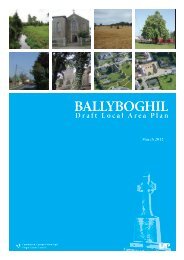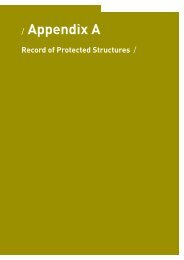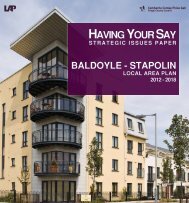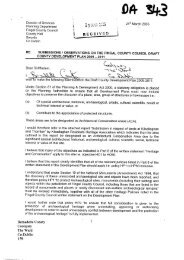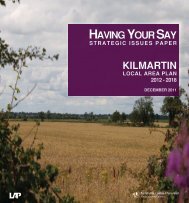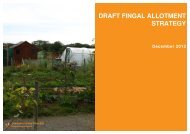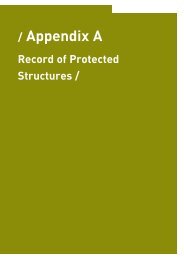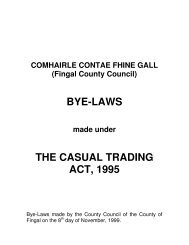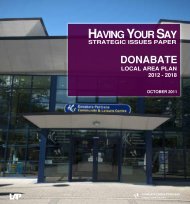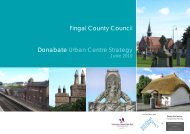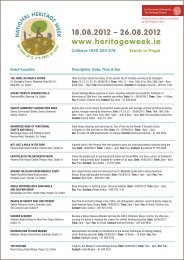Swords Masterplan - Fingal County Council
Swords Masterplan - Fingal County Council
Swords Masterplan - Fingal County Council
You also want an ePaper? Increase the reach of your titles
YUMPU automatically turns print PDFs into web optimized ePapers that Google loves.
Safety and Security<br />
The principles of ‘Safer Places: the planning system and crime prevention’ by the ODPM<br />
should be incorporated as part of any new development. The better practice guidance<br />
sets out the seven design principles that are sought in new and existing developments:<br />
● Access and movement<br />
● Structure<br />
● Surveillance<br />
● Ownership<br />
● Physical protection<br />
● Activity<br />
● Management and maintenance<br />
Please refer to Appendix 2 of this document for a summary of the document<br />
principles.<br />
THE RETAIL/COMMERCIAL CORE<br />
Whilst the Main Street experiences good safety and security measures, the<br />
backland areas and in particular the area fronting onto the river does not benefit<br />
from natural surveillance. Orientating building fronts to the river, CCTV and good<br />
lighting can help reduce the feeling of insecurity in this particular hot spot.<br />
CIVIC/COMMUNITY CORE<br />
The Seatown Road is popular with pedestrians travelling from the centre<br />
eastwards to the R132. However differing front boundary treatments and building<br />
setbacks make for differing levels of street security. Some are open plan, some<br />
have low boundaries whilst others have high walls and dense hedging.<br />
COMMERCIAL/RESIDENTIAL<br />
While buildings along North Street front onto the street they do not overlook the<br />
Town Park. The entrance laneway to <strong>Swords</strong> Town Park and the back lane<br />
associated with the terraced housing at the northwest of North Street are poorly<br />
lit and lacking in natural surveillance.<br />
Inactive frontage to the River Ward<br />
Protected Structures<br />
THE RETAIL/COMMERCIAL CORE<br />
The Main Street has a strong and distinctive streetscape, which should be protected<br />
if the town is to retain its unique character. <strong>Swords</strong> origins as a market town are<br />
evident in its wide Main Street, and its medieval importance is made clear in the<br />
surviving deep and narrow plots. There are several protected structures within the<br />
area of the Main Street.<br />
These include the following Protected Structures:<br />
Record No. Description<br />
351 <strong>Swords</strong> Castle<br />
352 Mill Bridge<br />
357 Old Borough School<br />
359 The Old School House Restaurant<br />
360 St. Columba’s Church (C of I)<br />
361 Sexton’s House<br />
362 Old Vicarage<br />
372 National Irish Bank<br />
Structures of note include:<br />
S W O R D S M A S T E R P L A N<br />
351 <strong>Swords</strong> Castle<br />
<strong>Swords</strong> Castle was built as the manorial residence of the Archbishops of Dublin<br />
around 1200. The castle covers a large pentagonal walled area of nearly 1.5 acres<br />
with a tower on the north and an impressive gateway complex on the south.<br />
352 Mill Bridge<br />
A single-arch rock faced limestone road bridge over the river Ward. Its<br />
construction dates from around 1870. The bridge consists of an ashlar limestone<br />
coping to parapet as well as a plaque inscribed with ‘Erected in the memory of<br />
Peter Wilson who gave his life for Irish freedom in the rising of Easter Week 1916,<br />
Ar dheis De go raibh a anam’.<br />
357 Old Borough School<br />
The old school is a detached nine-bay two-storey former national school house<br />
built around 1810 on a T-shaped plan. The roof is double pitched consisting of<br />
slate, concrete ridge tiles, granite coping. The openings are square headed with<br />
granite sills, timber sash windows, timber panelled door and overlight.<br />
359 The Old School House Restaurant<br />
A detached nine-bay two-storey former national school house built around 1810,<br />
on a T-shaped plan. The building is attributed to architect Francis Johnston. The<br />
roof is double pitched with slate, and rendered chimney stacks. The walls are<br />
smooth rendered. The openings are square headed with 6/6 timber sash<br />
windows. There is a round headed door opening to right porch with overlight.<br />
1 1 5<br />
361<br />
360<br />
362<br />
359<br />
352<br />
357<br />
372<br />
351<br />
351 360




